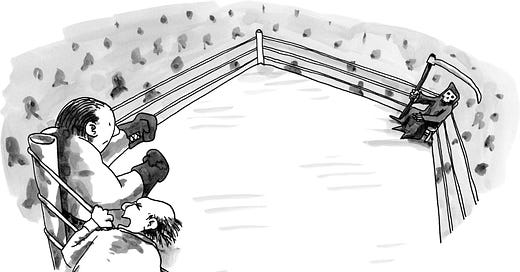Omnicom, IPG and WPP are Operating in "Survival Mode" . What Does this Mean for Clients and Employees?
To meet Wall Street's expectations, these Holding Companies must grow sales and widen margins, whatever the cost. Other professional goals take a back seat in their efforts to avoid being broken up.
Credit: Shannon Wheeler, The New Yorker, The Cartoon Bank
Wall Street is a fair-weather friend.
When things go well, share prices rise, C-Suite executives earn seven or eight-figure bonuses, and analysts praise the leadership acumen and genius of the CEOs. Companies increase their sales and margins with satisfied clients, headcounts increase, and promotion prospects remain attractive for existing employees, many of whom stay for long-term careers.
When things go very badly, Wall Street concludes that “the parts are worth more than the whole,” and “shareholder value” concerns lead to break-ups of the enterprise. The consequences are devastating for existing C-Suite executives, even though many of them are paid off handsomely despite their management failures.
Break-ups are not uncommon events:
Tyco International (multiple spin-offs in 2007 and 2012), Citigroup (post-2008 crisis), ITT Corporation (2011), Fortune Brands (2011), Sara Lee (2012), Kraft Foods (2012), Time Warner (2009–2014), News Corporation (2013), Abbott Labs / AbbVie (2013), eBay and PayPal (2015), Hewlett-Packard (2015), Xerox and Conduent (2017), MetLife (2017), United Technologies (2020) and General Electric (2021 announcement, 2024–2025 execution) are all examples of break-ups forced by outsiders and Wall Street insiders.
Within Madison Avenue, we’ve seen some early break-up hints: WPP unloaded 60% of Kantar (2019) to Bain Capital and IPG sold Huge and R/GA to private equity investors.
Between “things going well” and “things go very badly,” there is a grey zone where enterprises, like Omnicom, IPG and WPP enter survival mode:
Liquidating talent — expensive, senior staff members — to reduce costs.
Merging agencies and eliminating long-standing brands (and their cultures) to eliminate leadership structures and reduce overhead costs.
Pinning their hopes on “new business development wins” to provide growth.
Engaging in questionable principal-based media transactions to generate trading income.
Generally focusing on cost reductions to keep Wall Street at bay.
George A. von Peterffy (1929-2012), the renowned businessman, government intelligence officer and Harvard Business School professor, developed and taught “Von Peterffy’s Law” to his students:
*************************************************************************************
Von Peterffy’s Law
There are four main imperatives, objectives or laws of behavior you can expect of all organizations: government, public or private.
First, they will defend their existence to the death, even if the original rationale for creation has ceased;
Second, they will fervently seek to extend their scope of operation, regardless of good cause or need;
And third, and only after the first two objectives have been maximized, will they seek to accomplish the purpose for which they were created.
When things go badly, the third imperative, above, will be abandoned entirely.
*************************************************************************************
Holding Companies, originally established to enjoy the financial benefits of owning highly performing ad agencies (1960s-1980s), centralized their power after 2000 by establishing “holding company relationships” and continued the questionable practice of downsizing to generate growing profit margins.
In the process, they weakened their agencies, leading to the loss of long-term relationships and the beginning of today’s short cycle of new business development, agency onboarding and agency firings.
Undeterred by these failures, the Holding Companies doubled down by merging their agencies, continuing their downsizings, ignoring the need for pricing changes, and (worst of all) proposing to merge holding companies themselves (Omnicom and IPG) to take out another $750 million of costs.
Clients and employees are ill-served by the history of Holding Company strategic initiatives. Client legacy brands have not grown since 2009 — the industry’s enthusiastic adoption of low-cost programmatic media has been a complete bust. However, in the quest to lower costs even more, and to generate media trading income, Holding Companies are increasing their focus on programmatic media, even though there is strong evidence that it does not drive client brand growth at all.
Professor Von Peterffy would not be surprised by any of these developments.
“Companies will defend their existence to the death,” he would remind us, “and in the face of disaster, they’ll abandon the purpose for which they were created.”





Brand growth is a long term affair. CMO lifespan & client retention are both short term affairs. This is one of the reasons the focus has shifted, decades ago if you ask me. Neither CMO's or agencies care about building long term market success. I mean, not really, in public they will sing the correct song, but in practice, well, we can all see it with our own eyes. Fragmentation of media means fragmentation of message, parallel stories, nothing of meaning with any chance of becoming pop-culture. Ads have ceased to be watercooler subjects a long, long time ago.
Ok, where does the Omnicom-IPG merger fit? IPG have obviously been prepared to give it up.